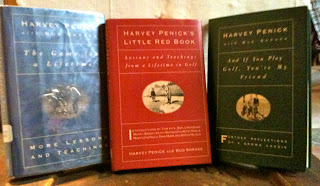 |
| They call it "Village GREENS" for a reason. |
Am I any better? If you judge by my scores at one course, I am. Earlier this week I played Village Greens, a par-56 course in nearby Sinking Spring, Pa., and shot an 85. That's more than 30 strokes better than the first time I played in August of 2011. So, yay for that.
The problem is, Village Greens, nice as it is, is much shorter than a typical golf course. And on those courses -- where you have to play more than two par-4 holes, not to mention the occasional par 5 -- I am nowhere close to improving.
For instance: Last September, I shot 152 and 133 at two par-70 courses. That's roughly 76 and 66 per nine holes. The last two times I played 18 holes of a regulation course, I shot 119 (yay!) and 140 (sigh).
The few times I've played even nine holes on a real course haven't been any better: 67 at one course and 72 at another.
Maybe it's too much to expect vast improvement over just a year's time. I'm certain the main reason I improved so much at Village Greens is that I play it often. (In my defense, the course is inexpensive and fast; I can complete a round of 18 holes in two hours or less.)
Another possibility is that the shortness of the course allows me to skip over a key part of the game: fairway shots. I don't often hit the green in regulation, but even on the par-3 holes, I can manage with a pitch or a chip to get there in two. I rarely -- just twice per round, to be precise -- need to hit the ball a great distance after the tee. And that's where I continue to struggle when I do play most par-4s and 5s. So by the time I get to the green, any chance I have at saving bogey -- even double bogey -- is ruined. By then I let the rest of my game suffer, too. (At Chapel Hill, as you'll see below, I managed two putts or fewer on just three of the nine holes.)
That's the big lesson: I think it's time to start playing regular golf courses, even if it's just nine holes at a time. Berks County, where I live, has a number of scenic, affordable courses where I can test myself -- and, perhaps, get a little bit better.
At least do better than 67 for nine holes. I mean, I know I'm a bad golfer, but that's just pathetic.
Now for the scorecards. First the good:
Here's how I played at a REAL course:
What's YOUR biggest golf weakness?




























